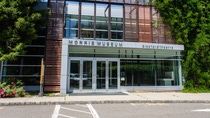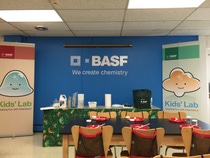Media
Morris Museum: Where art & science intersect
The community foundation’s newest head talks to BASF about kinetic art and its most unique exhibit.
.jpg)
.jpg)
Cleveland Johnson, Ph.D., Executive Director, Morris Museum.
Cleveland Johnson, Ph.D., is the new executive director of the Morris Museum—one of New Jersey's oldest and most active arts and cultural institutions.
Johnson, who started his new post on November 1, 2017 has a dynamic background. He’s the immediate past Director of the National Music Museum (NMM) in South Dakota. He’s also been a professor for 25 years, teaching music history. Then, he’s worked in the non-profit world. But his career, in fact, began as a professional church organist. It is no wonder that he took an interest in the position of Executive Director at the local community museum, which has the premier collection of its kind in the Western Hemisphere—mechanical musical instruments and automata from the Murtogh D. Guinness Collection.
This collection demonstrates how 19th-century technology brought sound and movement into artistic expression. And kinetic art (art that moves) is a rarity at museums, therefore Cleveland cannot sing enough praises about this unique collection.
“There’s nothing that compares to the Guinness Collection in this country. It’s really the most significant collection of its sort in the nation,” Johnson told BASF in an exclusive interview.
The Morris Museum's permanent exhibit, drawn from more than 750 objects in the Guinness Collection, offers an interactive experience for visitors of all ages. These mechanical musical instruments and automata are more than meets the eye, however. Inside and behind the classic costumes, hand-crafted cases and whimsical actions is hidden the vintage engineering that makes each unique item come to life. These automata tell the story of 19th-century robots.
“It gives us the potential to use the collection as a tool for teaching about science, about engineering, about technology,” Johnson added.
And this is where BASF Corp. comes in. Aside from being a major sponsor of the Morris Museum, the German chemical company also provides materials for children to learn more about science and chemistry at the museum’s company-sponsored lab. This BASF-branded space is where programs such as Kids’ Lab and summer Science Wednesdays take place.

“BASF is very prominent in our day-to-day here. It’s a very important supporter for us, particularly in the educational area,” said Johnson. “There’s something going on practically every week that’s utilizing BASF materials or things funded from BASF grants.”
The museum also uses a BASF-funded 3D printer to make small parts for science classrooms and exhibits such as the AutomataCon, a biennial convention devoted to automatons and kinetic art. Johnson said he hopes to eventually incorporate 3D printing into some of the museum’s Studio Art classes.
Since BASF embraces the notion that chemistry is all around us, including art. And the Morris Museum is a stone’s throw from the company’s North American headquarters, it was a logical step for the chemical company to collaborate with the award-winning establishment.
“This partnership allows us to reach even more young minds that may be uncomfortable with science but embrace art,” said Molly Borst, Manager, Science Education—North America, BASF, who not only manages company events at the museum, but is also on the Board of Trustees. “By revealing the not-so-obvious connections, we can inspire conversations and interactions with parents and children alike as they engage with exhibits.”
Other events that BASF sponsors at the Morristown, NJ facility include Family Fun Day, Tot Tours, Home School Programs and Special Family Programs.
Meanwhile, the new executive director is excited about some music-themed exhibits appearing at the museum soon. There’s a major exhibit coming up this fall from NMM, where he previously worked—called “Trumpets, Weird and Wonderful,” which will explore the history and science behind the well-known musical instrument.
As for down-the-line plans of the facility: Johnson wants to build stronger collaborations with other institutions and bring the Guinness collection—which has flown under the radar for a long time—to the forefront—as he sees great promise for the exhibit, which helps art and science intersect.
“When searching for a new director, the board knew we needed a fresh perspective,” Borst added. “Cleveland and his experience at the National Music Museum paired with curious exhibits of the Murtogh D. Guinness Collection at the Morris Museum, set the stage for a whole new world of possibilities and exhibitions to dazzle Morris County residents of all ages.”
You could almost say that Johnson has come full circle since the start of his career as a performing musician, to managing a museum rich in music history.
“(The) Guinness (exhibit) gives us an energy source and a very solid foundation to expand out and do things that no other museum in the country can do,” he concluded. “At most art museums, paintings hang quietly on the walls or sculptures stand immobile on platforms, but we have a perfect excuse to expand in a unique direction, embracing art that moves.”
Published by Anna Spiewak.
For media inquiries or to repurpose this article, contact Lisa Brown.